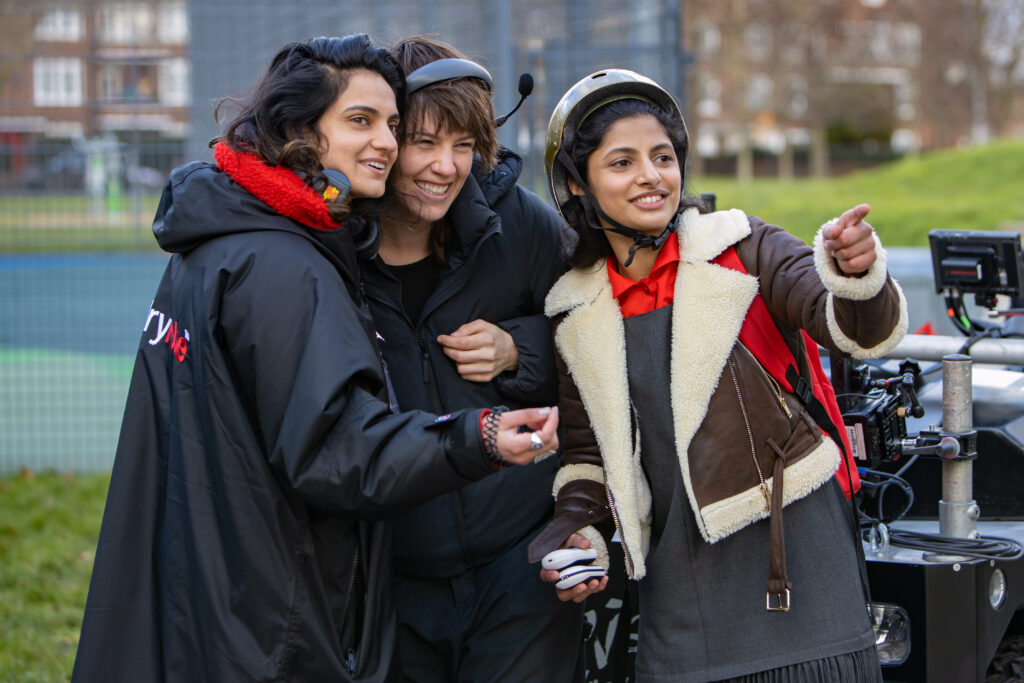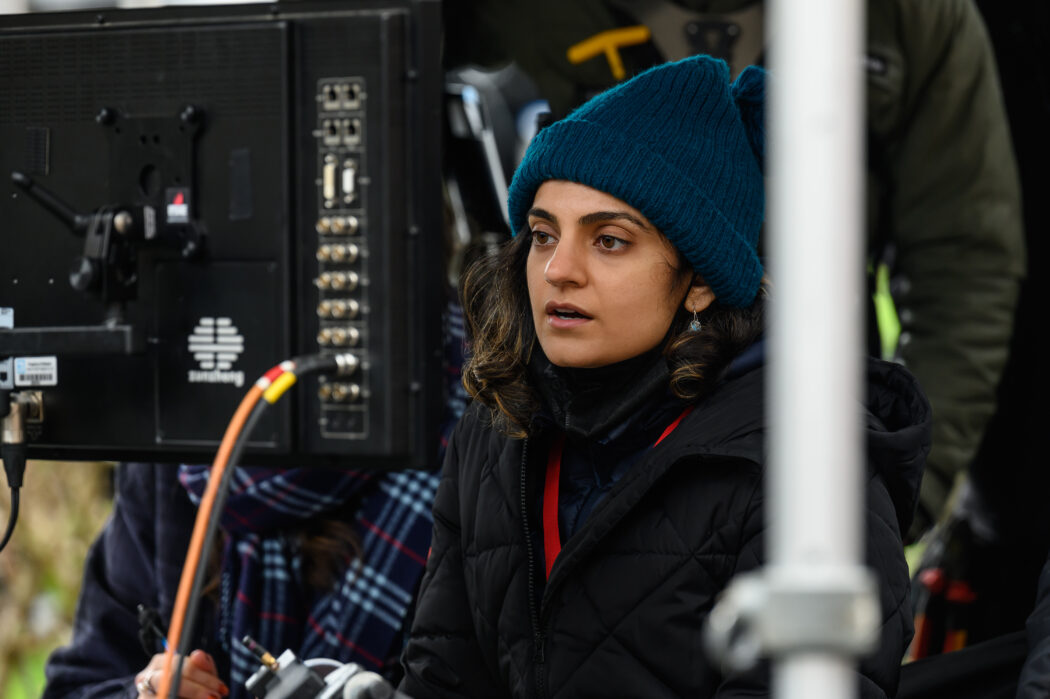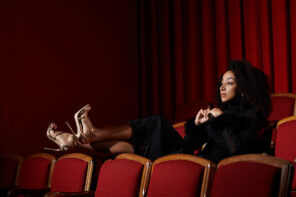The award-winning writer-director, Nida Manzoor talks to A.T.O.D about ‘Polite Society’, finding her voice and how the backlash of ‘We Are Lady Parts’ made her creatively fearless.
Ten years in the making, writer-director Nida Manzoor brings the genre-bending ‘Polite Society’ to the big screen for an action-packed adventure with a refreshing South Asian twist.
Nida Manzoor’s Polite Society follows aspiring stuntwoman Ria Khan [Priya Kansara] who believes that she must save her older sister Lena [Ritu Arya] from her impending marriage. After enlisting her friends’ help, she attempts to pull off the most ambitious of all wedding heists. Polite Society (rated 91% on Rotten Tomatoes) is an unmistakably British Comedy that seamlessly evolves into a family drama, heist, action and martial arts movie all-in-one. Through this blending of different genres, Manzoor wanted to explore womanhood and femininity.
“The action genre is quite perfect because being a teenage girl is almost internal angst and it was so fun to be able to use action to externalize those small violences. I love movies so my film was inevitably going to be one that wears its love of film on its sleeve”, says Manzoor.
Manzoor’s film directorial debut has taken a decade of work, passion, and vision, and this long and drawn-out process gave the director the opportunity to work on her craft and hone the skills she would need to bring this project to life. This meant writing and directing the award-winning comedy ‘We Are Lady Parts’ and British institution ‘Doctor Who.’ When directing the movie, Manzoor had a clear vision of telling this story through the eyes of Ria Khan and wanted this reflected through her directorial style.
“In a way it needed to feel like if this teenage girl was retelling this, this would be her film,” says Manzoor. “It’s stylised, it’s got rhythm because she’s a fighter, it’s got a big bold score like I’m doing a ‘Star Wars’ or ‘Oceans 11’. It has all that. But it needed to feel a little bit frenetic and rough around the edges.”
“We had the wild mentality in our filmmaking that if the focus wasn’t perfect, it doesn’t matter if the focus wasn’t perfect, she’s a teen, her focus isn’t perfect.”
The responsibility of capturing the essence of the Ria Khan that Manzoor had envisioned when writing the script all those years ago was put on the shoulders of Priya Kansara in her film debut, in what turned out to be inspired casting. Talking about Kansara, Manzoor said: “We had a long casting process and I’d seen lots of actors and non-actors but I hadn’t seen anyone who even came close to feeling what Ria Khan was meant to feel like for me, someone who had lived with this character for 10 years, until Priya Kansara walked in.”
Manzoor continues, “She inhabited this character in the most perfect way and I was at the monitor in awe most of the time with how she understood the tonal shifts, how she could do the vulnerable and do the silly and be an incredible comedy actor but also have insane pathos.” She adds, “She had all these different elements and I still honestly can’t believe how new she is to the game because of how much talent and professionalism she has.”
In the past, it has always been difficult to predict whether a British Comedy would translate across the pond and have the same effect on an American audience due to subtle humour differences. However, ‘Polite Society’ was clearly successful in accomplishing this difficult task as it was selected to premiere at this year’s Sundance Film Festival.
It was a dream come true,” recalls Manzoor. “I think I had been dreaming of a festival premiere for those 10 years while making it. Sundance … mate, top of the list! I had a blast. It was joyful. It was overwhelming. There could have been two people in the audience and I would have been like, I’m at Sundance premiering my film, nothing else matters!
Manzoor rose to prominence for the success of We Are Lady Parts, a comedy she wrote about an all-Muslim female punk band, in which she was awarded the Rose d’Or in 2021 in the “Emerging Talent” category.
In that moment of gratitude, Manzoor notes [that], “Winning an award is always nice, but I think it was more just the fact of getting to make ‘We Are Lady Parts’ and finding my voice and figuring out the things I want to talk about–and [to] believe in myself. So much of my early years in the industry, I had very low self-confidence because nobody wanted to make ‘Polite Society’. And ‘We Are Lady Parts’ was definitely not embraced by everyone when I was trying to get it made. So yeah, the success of the show did give me a boost in terms of believing in myself and realizing my voice is worth something.”

Director Nida Manzoor, cinematographer Ashley Connor and actor Priya Kansara on the set of their film POLITE SOCIETY. Credit: Saima Khalid / © 2023 FOCUS FEATURES LLC.
However, despite the acclaim and success of ‘We Are Lady Parts’, Manzoor had to delete her social media accounts after a torrent of abuse due to the show’s portrayal of Muslim women. The series pilot episode received a lot of backlash, negatively affecting Manzoor’s creative confidence [briefly], but she found the experience transformative—and eventually, cathartic. Much like the characters we admire in her films, Manzoor has a tenacity and determination that is admirable and worthy of noting.
“I had this insane therapy of making a television show to explore what it feels like to be an artist from a marginalized background, and have that weight of representation on your shoulders. But going through that and having had that experience of not everyone taking to my work was actually really freeing for me.
When I came to making ‘Polite Society’ I didn’t experience this burden in the same way. Your film won’t be for everyone. It just won’t. And so it’s so freeing to just focus on what I love and make the film that I would make for myself, and knowing that would be enough.”
To date, the rise of women behind the camera is slow going. In spite of progress, little changes have occurred, which is why we were thrilled to have the opportunity to celebrate a female filmmaker as creatively fearless as Manzoor. In honor of writers, creators, and storytellers throughout the world and within this industry, please continue sharing your lens of the world.
Thank you to Nida Manzoor for sharing a bit of your journey with readers.
POLITE SOCIETY is in Theatres NOW.
To learn more about strides being made, as well as existing glass ceilings and sticky floors, see the data below.
RECENT STATISTICS ON WOMEN IN FILM + TV
SUNDANCE 2023 STATS
- Filmmakers’ chances of making it through the selection process are below 1%.
- The 2022 Festival lineup included 82 feature films, 15 New Frontier projects, and six indie episodic features.
- 91% of the Festival’s feature films in 2022 were world premieres.
- Of the nearly 11 000 Short Films that were submitted for the lineup in 2023, only a little over 60 were eventually selected.
- 4 Indie Episodic projects in 2023 were chosen from over 500 submissions.
- The 2023 Short Film programme featured work from 20+ countries.
- In 2023, over 40% of the directors willing to share identity information identified as women.
- In this same programme, nearly 60% of directors identified as people of colour.
SDSU | San Diego State University Research
- In 2022, 33% of films featured female protagonists, up 2 percentage points from 31% in 2021.
- Women comprised 38% of major characters, up 3 percentage points from 35% in 2021.
- Females accounted for 37% of all speaking characters, up 3 percentage points from 34% in 2021.
- 80% of films featured more male than female characters.
- Only 11% of films had more female than male characters, and 9% of films featured equal numbers of female and male characters.
- Female characters were younger than their male counterparts, diminishing in alarming numbers around the age of 40.
- Female characters in speaking roles experienced a precipitous drop from their 30s to their 40s.
- 36% of female characters were in their 30s but only 14% were in their 40s.
- The percentage of female characters in their 40s was actually lower in 2022 (14%) than in 2015 (20%).
- Regarding race and ethnicity, Black females comprised 21.6% of all major female characters in 2022, up from 16.4% in 2021.
- The percentage of major Latina characters declined from 12.8% in 2021 to 7.0% in 2022, and the percentage of major Asian and Asian American females declined from 10.0% in 2021 to 6.6% in 2022.

Priya Kansara stars as Ria Khan in director Nida Manzoor’s POLITE SOCIETY, a Focus Features release. Credit: Parisa Taghizadeh / © 2023 FOCUS FEATURES LLC.
The Celluloid Ceiling: Employment of Behind-the-Scenes Women on Top Grossing U.S. Films in 2022
The Celluloid Ceiling has tracked women’s employment on the 250 top (domestic) grossing films for the last 25 years. Having monitored credits for a quarter of a century, the project provides the longest-running and most comprehensive record of women’s behind-the-scenes employment available. Taking the long view, the percentage of women working as directors, writers, producers, executive producers, editors, and cinematographers increased a scant 7 percentage points from 17% in 1998 to 24% in 2022. This represents a decline of 1 percentage point from 25% in 2021. By role, women comprised 18% of directors, 19% of writers, 25% of executive producers, 31% of producers, 21% of editors, and 7% of cinematographers last year. Films with at least one woman director employed substantially more women in other key behind-the-scenes roles than films with exclusively male directors. The report also includes the percentages of women working on the top 100 grossing films.
Women and Hollywood Report, 2020
Employed television writers
- Women were 45.3% of TV series writers and 35.2% of development/pilot writers.
- BIPOC folks were 37% of TV series writers and 23.3% of development/pilot writers.
- BIPOC women made up 21.4% of TV series writers and 9.9% of development/pilot writers. BIPOC men made up 15.3% and 13.2%, respectively.
- White women comprised 25.9% of TV series writers and 25.9% of development/pilot writers.
- Of TV series writers, 15.5% were Black, <1% were Native American/Indigenous, 5.9% were Latinx, 6.4% were Asian/South Asian/Pacific Islander, <1% were Middle Eastern, and 8% were multi-ethnic/racial.
- Of development/pilot writers, 9.7% were Black, <1% were Native American/Indigenous, 3.2% were Latinx, 5.9% were Asian/South Asian/Pacific Islander, <1% were Middle Eastern, and 3.8% were multi-ethnic/racial.
- LGBTQ+ folks accounted for 11.6% of TV series writers and 6.4% of development/pilot writers.
- Writers with disabilities represented 1.7% of TV series writers and 1% of development/pilot writers.
- Writers aged 55 or over comprised 15.2% of TV series writers and 20.4% of development/pilot writers.
- Women made up 63.1% of staff writers, 60.4% of story editors, 60.1% of executive story editors, 46.5% of co-producers, 57.5% of producers, 43.6% of supervising producers, 44.5% of co-executive producers, and 27.6% of executive producers or showrunners.
- BIPOC folks comprised 55.6% of staff writers, 61% of story editors, 52.6% of executive story editors, 53.1% of co-producers, 45% of producers, 46.2% of supervising producers, 27.3% of co-executive producers, and 17.9% of executive producers or showrunners.
- BIPOC women were 36.6% of staff writers, 39.3% of story editors, 35.7% of executive story editors, 26.8% of co-producers, 28% producers, 24.3% of supervising producers, 16.3% of consulting producers, 15.1% of co-executive producers, 7.4% of executive producers, and 6.9% of showrunners.
- White women represented 28.3% of staff writers, 21.4% of story editors, 27.9% of executive story editors, 21.8% of co-producers, 29% of producers, 20.4% of supervising producers, 31.3% of consulting producers, 31.3% of co-executive producers, 18.8% of executive producers, and 23.6% of showrunners.
- BIPOC men accounted for 17.7% of staff writers, 21.4% of story editors, 16.3% of executive story editors, 26.1% of co-producers, 17% of producers, 21.4% of supervising producers, 17.5% of consulting producers, 11.9% of co-executive producers, 10% of executive producers, and 11.8% of showrunners.
Of the TV writers employed 2010-2020
- Women writers grew from 29.3% of TV writers employed to 45.3%.
- BIPOC writers have increased from 13.6% of TV writers employed to 37%.









1 Comment